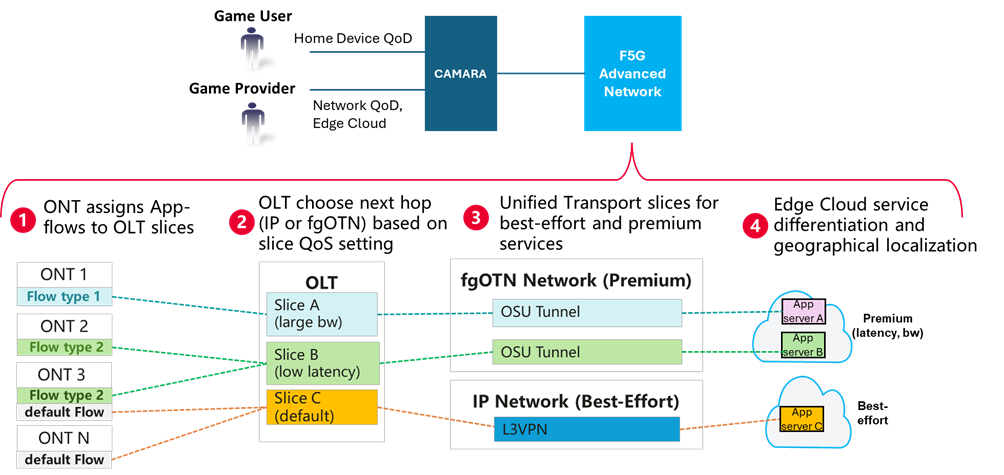F5G Advanced Premium Cloud Immersive Services showcased at MWC’25
At the Mobile World Congress 2025, the Centre Tecnològic de Telecomunicacions de Catalunya (CTTC) and Huawei Technologies showcased a cutting-edge Proof of Concept (PoC) focused on the development of a standards-based and open-source Network-as-a-Service (NaaS) platform. This initiative aligns with specifications from key standards organizations such as ETSI, IETF, and CAMARA, and is built upon open-source components including ETSI TeraFlowSDN (TFS) and ETSI Open Source MANO (OSM). The proposed solution highlights the capabilities of the ETSI Industrial Specification Group (ISG) Fifth Generation Fixed (F5G) Network. This demonstration introduced a set of technical Fixed 5G technology enhancements focused on end-to-end service delivery and network automation, using an immersive Augmented Reality/Virtual Reality (AR/VR) Gaming Service for Remote Players as a practical application of the F5G Advanced (F5G-A) architecture. The platform demonstrated end-to-end QoD capabilities, incorporating application-flow classification and differentiation. To support this, the setup was expanded to include a dedicated IP transport network for best-effort traffic, operating alongside the fine-grain Optical Transport Network (fgOTN), which was used for traffic requiring guaranteed Quality of Service (QoS). This allowed the system to differentiate between traffic types and manage them accordingly.

At Mobile World Congress 2025, the Centre Tecnològic de Telecomunicacions de Catalunya (CTTC) and Huawei Technologies showcased a cutting-edge Proof of Concept (PoC) focused on the development of a standards-based and open-source Network-as-a-Service (NaaS) platform. This initiative aligns with specifications from key standards organizations such as ETSI, IETF, and CAMARA, and is built upon open-source components including ETSI TeraFlowSDN (TFS) and ETSI Open Source MANO (OSM).
The goal of the PoC was twofold: first, to demonstrate the feasibility of a reference NaaS implementation grounded in open standards; and second, to enhance service quality and user experience by integrating CAMARA Quality-on-Demand (QoD) service APIs with F5G-Advanced network technologies. This combination enables flexible, intent-driven connectivity tailored to application requirements in real time.
The PoC was carried out in two phases. The first phase established the foundation by implementing a basic NaaS platform, which was showcased at Mobile World Congress (MWC) 2024. This phase highlighted QoD services through application flow isolation, achieved by leveraging network slicing and cloud integration. This approach enabled differentiated handling of traffic flows based on specific service requirements.
Building on this foundation, the second phase was presented at MWC 2025, introducing a set of technical enhancements focused on end-to-end service delivery and network automation. In this phase, the platform demonstrated end-to-end QoD capabilities, incorporating application-flow classification and differentiation. To support this, the setup was expanded to include a dedicated IP transport network for best-effort traffic, operating alongside the fine-grain Optical Transport Network (fgOTN), which was used for traffic requiring guaranteed QoS. This allowed the system to differentiate between traffic types and manage them accordingly.
Lluis Gifre and Shayan Hajipour (CTTC), along with Hesam Rahimi (Huawei Canada) performed the demonstration of the developed NaaS platform focused on immersive cloud AR/VR gaming in the CTTC booth (CS Stand CS210). A VR headset was used to show the application, and it raised interest from congress delegates. We also had the visit of an ETSI delegation composed of Jan Ellsberger, Director General of ETSI, Ultan Mulligan, Chief Services Officer, and Issam Toufik, Chief Technical Officer.

Institutional picture with ETSI Director General and CxOs, ETSI ISG F5G leaders, and key contributors from Huawei Technologies and CTTC

ETSI Director General trying the immersive VR application supported by the proposed NaaS platform
A key development in this second phase was the automation of the access network. In the previous implementation, devices such as Optical Network Terminals (ONTs) and Optical Line Terminals (OLTs) were provisioned manually. In Phase 2, a dynamic control plane was introduced for the access network, integrated with the end-to-end network orchestrator. This approach addressed the limitations of traditional Passive Optical Network (PON) configurations, which are typically static and require manual intervention. The introduction of dynamic slicing in the access network enabled several improvements. These included real-time resource allocation, allowing bandwidth and network resources to be adjusted based on current demand; service isolation, ensuring that different services and tenants operate independently without interference; and increased scalability, enabling the system to accommodate a higher number of users and applications with reduced operational overhead.

Application flow differentiation and its mapping to service slices and transport network slices
The architecture of the NaaS platform developed introduced a hierarchy of F5G-A domain controllers, featuring a new Aggregation Network (AggNet) Controller that orchestrates services across IP and fgOTN transport networks. The system is built using cloud-native, open-source components, including ETSI TeraFlowSDN (TFS) for the IP transport, aggregation, and E2E controllers, and ETSI Open Source MANO (OSM) for service orchestration. The IP and fgOTN controllers use IETF L3SM and ACTN models as northbound interfaces toward the AggNet Controller, which deploys IETF Network Slices across transport domains. The E2E orchestrator integrates with the PON access controller via the BBF App-flow API (in development) and with the AggNet Controller using the IETF Network Slice model (in development). It also interfaces with the cloud layer via Kubernetes APIs to deploy AR/VR gaming workloads. All services are exposed as 3GPP network slices through CAMARA APIs, allowing AR/VR game developers to access NaaS capabilities via standardized service interfaces.

Complete software stack used in the NaaS platform detailing the relevant standard interfaces and open-source software involved
Looking ahead, the PoC will continue to evolve, with future iterations planned for upcoming industry events. These next steps aim to incorporate real-time QoD monitoring through advanced telemetry and analytics, enabling continuous insight into service performance and compliance. Furthermore, the platform will introduce closed-loop automation for QoD assurance—capable of dynamically adjusting network behavior based on real-time data and intent-based policies. These enhancements will push the platform toward autonomous, self-optimizing network operation, completing the vision of a fully adaptive and intelligent NaaS solution.

